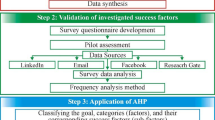Abstract
Global software development (GSD) is an area that receives much attention from researchers today. In this context, we undertook an investigation of the variation of risk profile in offshore-outsourced software projects, across the software life cycle. The scope of the investigation was limited to risks associated with technical aspects, methods, and procedures used in software development. Based on literature survey, we developed a questionnaire to measure the risks and outcomes in software projects. Using the questionnaire, we conducted a survey of 145 software projects executed by global IT companies. We built a structural equation model showing the interdependence of underlying risk factors and their influence on project outcome. We further explored how the risk profile varied across the software life cycle stages such as development, maintenance, and modernization.






Similar content being viewed by others
Abbreviations
- CMMI:
-
Capability Maturity Model Integration, 2010
- GDSP:
-
Geographically Distributed Software Projects
- GSW:
-
Global Software Development
- ODC:
-
Offshore Development Centre (a dedicated centre located at the vendor site at offshore for providing software services exclusively for a client, having the look and feel of the client’s IT environment)
- IS:
-
Information systems
- IT:
-
Information technology
- PM:
-
Project manager
- Risk:
-
In this study, this term represents risks in software development (in the absence of other qualifiers)
- SLA:
-
Service Level Agreement, a contractual agreement to provide a defined level of services with respect cost, schedule and technical performance
- SME:
-
Subject matter expert
References
Addison, T., & Vallabh, S. (2002). Controlling software project risks – an empirical study of methods used by experienced project managers. In Proceedings of SAICSIT 2002 (pp. 128–140).
Ahuja, M., Sinclair, R., & Sarker, S. (2013). The influence of outsourcing models on vendor knowledge integration. Journal of Information Technology Theory and Application, 13(4).
Boehm, B. (1991). Software risk management: principles and practices. IEEE Software, 8(1), 32–41.
Carr, M., Konda, S., Monarch, I., Ulrich, F., & Walker, C. (1993). Taxonomy-based risk identification. Software Engineering Institute, 1–24.
Colomo-Palacios, R., Casado-Lumbreras, C., Soto-Acosta, P., García-Peñalvo, F. J., & Tovar, E. (2014). Project managers in global software development teams: a study of the effects on productivity and performance. Software Quality Journal, 22(1), 3–19.
Hair, J. F., Black, W. C., Babin, B. J., & Anderson, R. E. (2010). Multivariate data analysis. Pearson Education India.
Iacovou, C. L., & Nakatsu, R. (2008). A risk profile of offshore-outsourced development projects. Communications of the ACM, 51(6), 89–94.
Jones, C. (2007) Estimating Software Costs: Bringing Realism to Estimating. Maintenance and Enhancement Estimating (pp. 557-599). Tata McGraw-Hill.
Kerzner, H., & Kerzner, H. R. (2017). Project management: systems approach to planning, scheduling, and controlling. Risk Management (pp. 743–745). John Wiley & Sons.
Kotler, P., & Keller, K. L. (2013). Marketing management 14e. Pearson Education Limited.
Lacity, M., & Rottman, J. (2008). Offshore outsourcing of IT work. In Offshore outsourcing of IT work (pp. 1–53). Palgrave Macmillan, London: Springer.
Lehman, M. M. (1979). On understanding laws, evolution, and conservation in the large-program life cycle. The Journal of Systems and Software, 1, 213–221.
Madhani, P. M. (2008). Indian software success story: a resource-based view of competitive advantages. The Icfaian Journal of Management Research, 7(8), 61–83.
Martens, B., & Teuteberg, F. (2009). Why risk management matters in IT outsourcing-a systematic literature review and elements of a research agenda. ECIS 2009 Proceedings. https://aisel.aisnet.org/ecis2009/451. Accessed 25 March 2017.
Mathur Jain, D., & Khurana, R. (2013). Need for sustainable global business model in software outsourcing. Business Process Management Journal, 19(1), 54–69.
Nidumolu, S. (1995). The effect of coordination and uncertainty on software project performance: residual performance risk as an intervening variable. Information Systems Research, 6(3), 191–219.
Oz, E., & Sosik, J. J. (2000). Why information systems projects are abandoned: a leadership and communication theory and exploratory. The Journal of Computer Information Systems, 41(1), 66–78.
Persson, J. S., Mathiassen, L., Boeg, J., Madsen, T. S., & Steinson, F. (2009). Managing risks in distributed software projects: an integrative framework. IEEE Transactions on Engineering Management, 56(3), 508–532.
Pressman, R. S. (2009). Software engineering a practitioner’s approach. Software testing strategies (pp. 449–478). Palgrave Macmillan.
Schmidt, R., Lyytinen, K., Keil, M., & Cule, P. (2001). Identifying software project risk: an international Delphi study. Journal of Managment Information System, 17(4), 5–36.
Team, C. P. (2010). CMMI® for Development, Version 1.3, Improving processes for developing better products and services. no. CMU/SEI-2010-TR-033. Software Engineering Institute.
Thomas, S., & Bhasi, M. (2012). Software development project risk. International Journal of Information Technology Project Management, 3(4), 41–55.
Vlaar, P. W., van Fenema, P. C., & Tiwari, V. (2008). Cocreating understanding and value in distributed work: how members of onsite and offshore vendor teams give, make, demand, and break sense. MIS Quarterly, 32(2), 227–255.
Wallace, L., & Keil, M. (2004). Software project risks and their effect on outcomes. Communications of the ACM, 47(4), 68–73.
Zhang, S., Tremaine, M., Milewski, A. E., Fjermestad, J., & O’Sullivan, P. (2012). Leader delegation in global software teams: occurrence and effects. Electronic Markets, 22(1), 37–48.
Author information
Authors and Affiliations
Corresponding author
Additional information
Publisher’s note
Springer Nature remains neutral with regard to jurisdictional claims in published maps and institutional affiliations.
Software life cycle
Software life cycle
In this study, the authors use the term “software life cycle” to encompass the transformational stages in the life of software namely, development, maintenance, and modernization, where changes to software code is involved.
Rights and permissions
About this article
Cite this article
Sundararajan, S., Marath, B. & K. Vijayaraghavan, P. Variation of risk profile across software life cycle in IS outsourcing. Software Qual J 27, 1563–1582 (2019). https://doi.org/10.1007/s11219-019-09451-8
Published:
Issue Date:
DOI: https://doi.org/10.1007/s11219-019-09451-8




